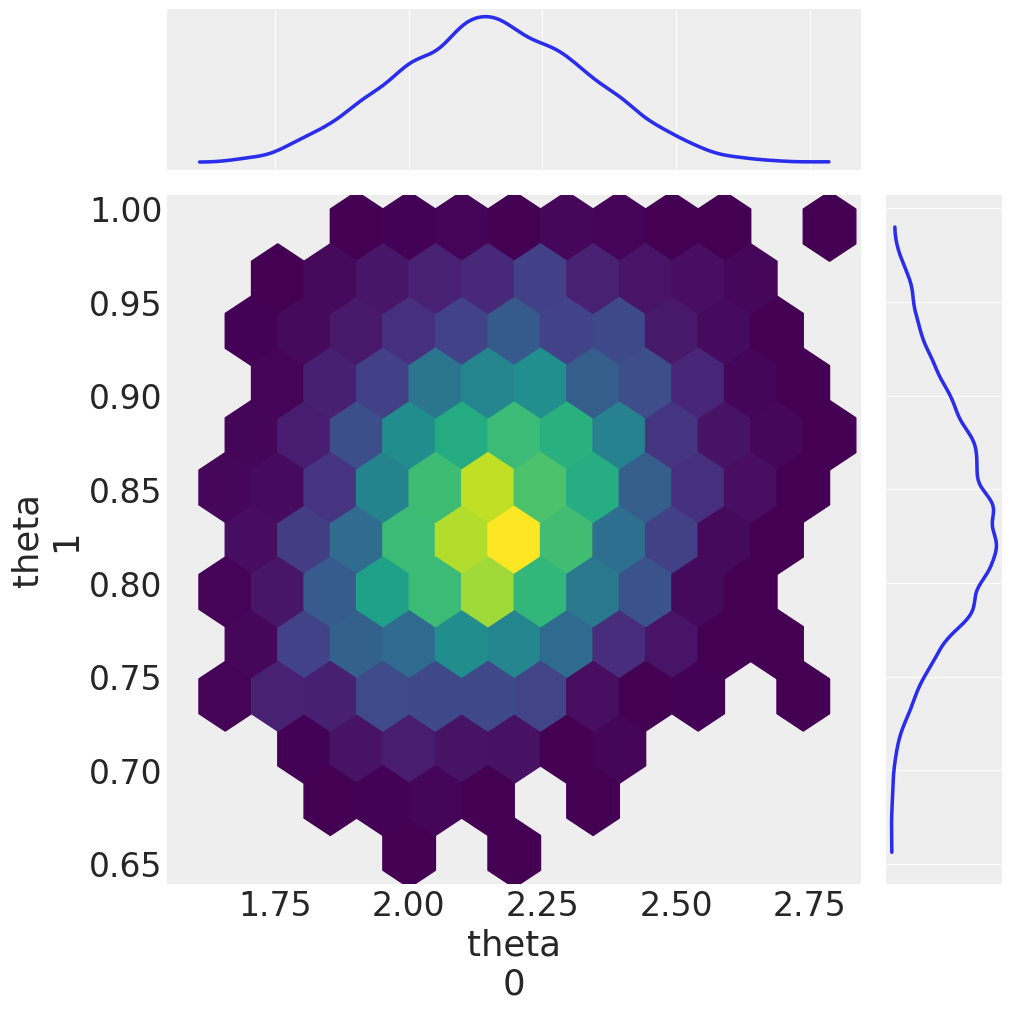MCMC diagnostics with Arviz¶
This tutorial shows how to evaluate the quality of MCMC samples generated via sbi using the arviz package.
Outline:
- Train MNLE to approximate the likelihood underlying the simulator
- Run MCMC using
pyroMCMC samplers viasbiinterface - Use
arvizto visualize the posterior, predictive distributions and MCMC diagnostics.
import arviz as az
import torch
from pyro.distributions import InverseGamma
from torch.distributions import Beta, Binomial, Gamma
from sbi.inference import MNLE, MCMCPosterior, likelihood_estimator_based_potential
from sbi.utils import MultipleIndependent
# Seeding
torch.manual_seed(1);
# Toy simulator for mixed data
def mixed_simulator(theta):
beta, ps = theta[:, :1], theta[:, 1:]
choices = Binomial(probs=ps).sample()
rts = InverseGamma(concentration=2 * torch.ones_like(beta), rate=beta).sample()
return torch.cat((rts, choices), dim=1)
# Define independent priors for each dimension.
prior = MultipleIndependent(
[
Gamma(torch.tensor([1.0]), torch.tensor([0.5])),
Beta(torch.tensor([2.0]), torch.tensor([2.0])),
],
validate_args=False,
)
Train MNLE to approximate the likelihood¶
For this tutorial, we will use a simple simulator with two parameters. For details see the example on the decision making model.
Here, we pass mcmc_method="nuts" in order to use the underlying pyro No-U-turn sampler, but it would work as well with other samplers (e.g. “slice_np_vectorized”, “hmc”).
Additionally, when calling posterior.sample(...) we pass return_arviz=True so that the Arviz InferenceData object is returned. This object gives us access to the wealth of MCMC diagnostics tool provided by arviz.
# Generate training data and train MNLE.
num_simulations = 10000
theta = prior.sample((num_simulations,))
x = mixed_simulator(theta)
trainer = MNLE(prior)
likelihood_estimator = trainer.append_simulations(theta, x).train()
/Users/janteusen/qode/sbi/sbi/neural_nets/mnle.py:60: UserWarning: The mixed neural likelihood estimator assumes that x contains
continuous data in the first n-1 columns (e.g., reaction times) and
categorical data in the last column (e.g., corresponding choices). If
this is not the case for the passed `x` do not use this function.
warnings.warn(
Neural network successfully converged after 65 epochs.
Run Pyro NUTS MCMC and obtain arviz InferenceData object¶
# Simulate "observed" data x_o
torch.manual_seed(42)
num_trials = 100
theta_o = prior.sample((1,))
x_o = mixed_simulator(theta_o.repeat(num_trials, 1))
# Set MCMC parameters and run Pyro NUTS.
mcmc_parameters = dict(
num_chains=4,
thin=5,
warmup_steps=50,
init_strategy="proposal",
method="nuts",
)
num_samples = 1000
# get the potential function and parameter transform for constructing the posterior
potential_fn, parameter_transform = likelihood_estimator_based_potential(
likelihood_estimator, prior, x_o
)
mnle_posterior = MCMCPosterior(
potential_fn, proposal=prior, theta_transform=parameter_transform, **mcmc_parameters
)
mnle_samples = mnle_posterior.sample(
(num_samples,), x=x_o, show_progress_bars=False
)
# get arviz InferenceData object from posterior
inference_data = mnle_posterior.get_arviz_inference_data()
/Users/janteusen/qode/sbi/sbi/utils/sbiutils.py:341: UserWarning: An x with a batch size of 100 was passed. It will be interpreted as a batch of independent and identically
distributed data X={x_1, ..., x_n}, i.e., data generated based on the
same underlying (unknown) parameter. The resulting posterior will be with
respect to entire batch, i.e,. p(theta | X).
warnings.warn(
/Users/janteusen/miniconda3/envs/sbi/lib/python3.8/site-packages/torch/__init__.py:690: UserWarning: torch.set_default_tensor_type() is deprecated as of PyTorch 2.1, please use torch.set_default_dtype() and torch.set_default_device() as alternatives. (Triggered internally at /Users/runner/work/pytorch/pytorch/pytorch/torch/csrc/tensor/python_tensor.cpp:453.)
_C._set_default_tensor_type(t)
/Users/janteusen/miniconda3/envs/sbi/lib/python3.8/site-packages/torch/__init__.py:690: UserWarning: torch.set_default_tensor_type() is deprecated as of PyTorch 2.1, please use torch.set_default_dtype() and torch.set_default_device() as alternatives. (Triggered internally at /Users/runner/work/pytorch/pytorch/pytorch/torch/csrc/tensor/python_tensor.cpp:453.)
_C._set_default_tensor_type(t)
/Users/janteusen/miniconda3/envs/sbi/lib/python3.8/site-packages/torch/__init__.py:690: UserWarning: torch.set_default_tensor_type() is deprecated as of PyTorch 2.1, please use torch.set_default_dtype() and torch.set_default_device() as alternatives. (Triggered internally at /Users/runner/work/pytorch/pytorch/pytorch/torch/csrc/tensor/python_tensor.cpp:453.)
_C._set_default_tensor_type(t)
/Users/janteusen/miniconda3/envs/sbi/lib/python3.8/site-packages/torch/__init__.py:690: UserWarning: torch.set_default_tensor_type() is deprecated as of PyTorch 2.1, please use torch.set_default_dtype() and torch.set_default_device() as alternatives. (Triggered internally at /Users/runner/work/pytorch/pytorch/pytorch/torch/csrc/tensor/python_tensor.cpp:453.)
_C._set_default_tensor_type(t)
Generate arviz plots¶
The resulting InferenceData object can be passed to most arviz plotting functions, and there are plenty see here for an overview.
To get a better understanding of the InferenceData object see here.
Below and overview of common MCMC diagnostics plot, see the corresponding arviz documentation for interpretation of the plots.
We will a full use-case using the SBI-MCMC-arviz workflow soon.
print(inference_data.posterior)
<xarray.Dataset>
Dimensions: (chain: 4, draw: 1254, theta_dim_0: 2)
Coordinates:
* chain (chain) int64 0 1 2 3
* draw (draw) int64 0 1 2 3 4 5 6 ... 1248 1249 1250 1251 1252 1253
* theta_dim_0 (theta_dim_0) int64 0 1
Data variables:
theta (chain, draw, theta_dim_0) float32 2.195 0.8838 ... 2.593 0.806
Attributes:
created_at: 2024-03-06T13:33:00.426835
arviz_version: 0.15.1
Diagnostic plots¶
az.style.use("arviz-darkgrid")
az.plot_rank(inference_data)
array([<Axes: title={'center': 'theta\n0'}, xlabel='Rank (all chains)', ylabel='Chain'>,
<Axes: title={'center': 'theta\n1'}, xlabel='Rank (all chains)', ylabel='Chain'>],
dtype=object)
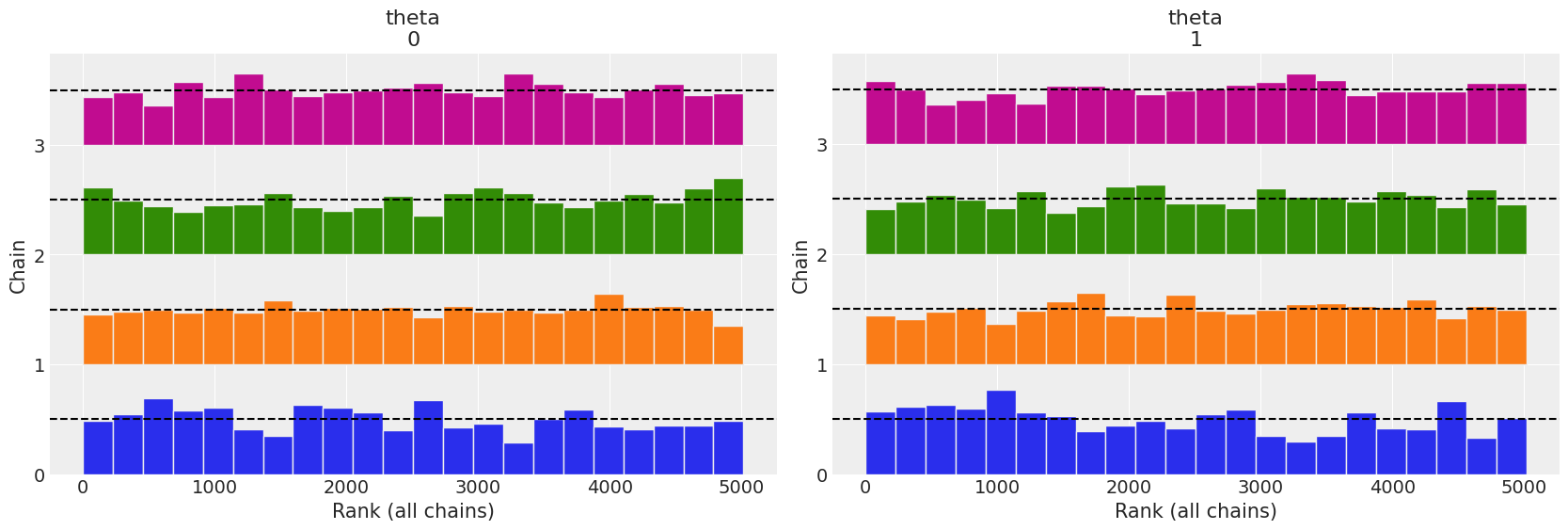
az.plot_autocorr(inference_data);
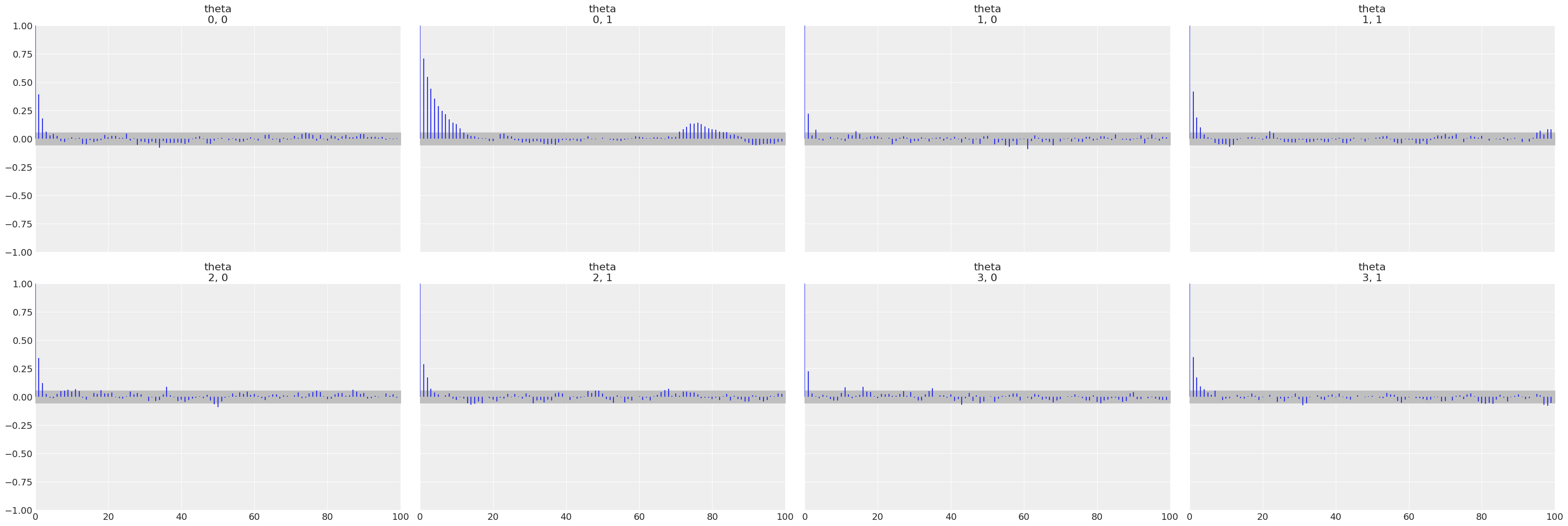
az.plot_trace(inference_data, compact=False);
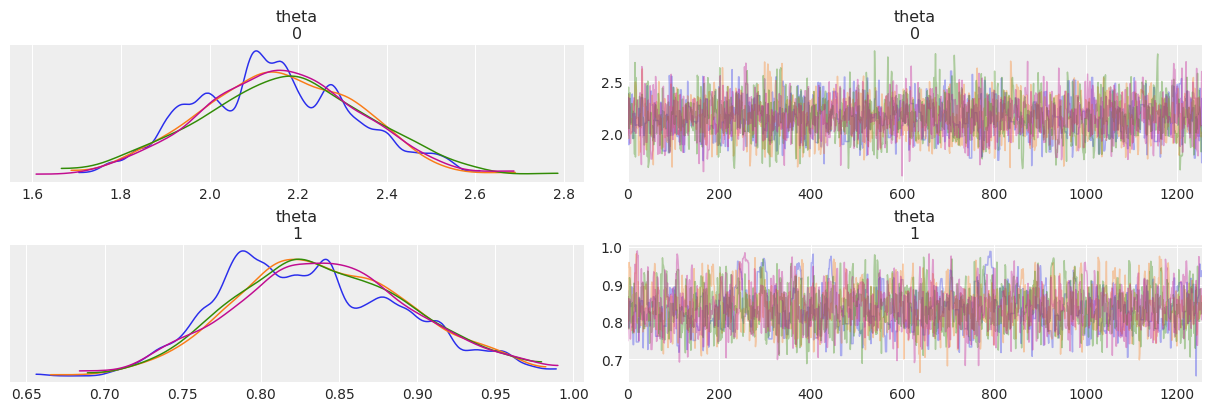
az.plot_ess(inference_data, kind="evolution");
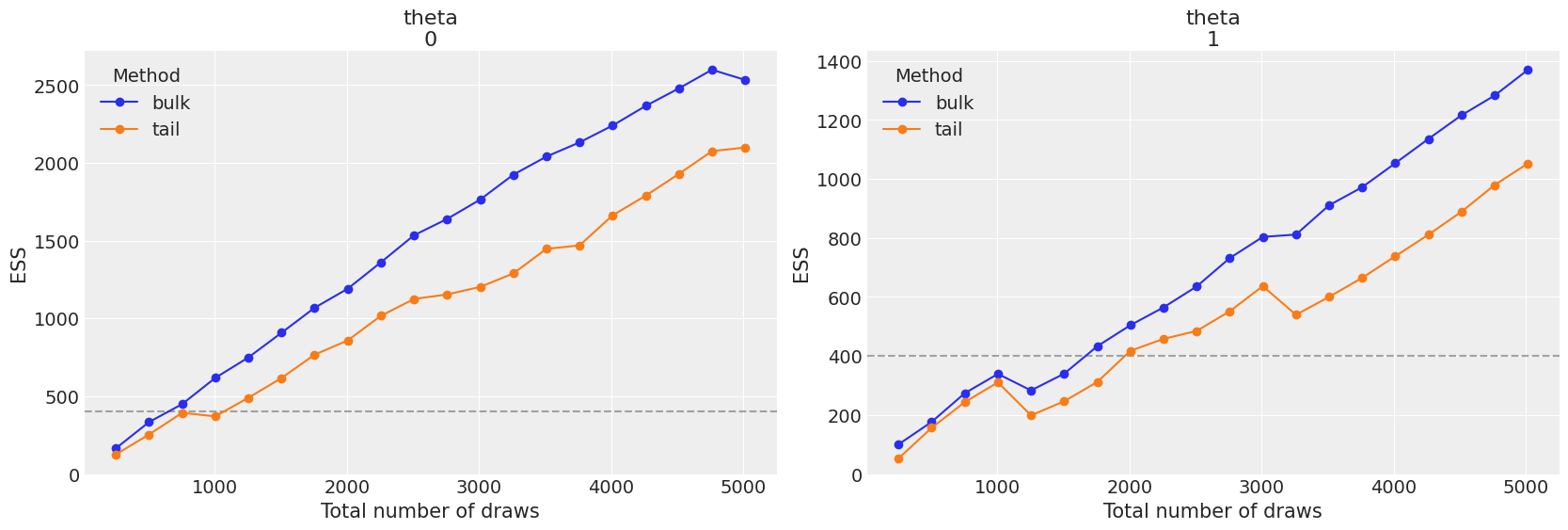
Posterior density plots¶
az.plot_posterior(inference_data)
array([<Axes: title={'center': 'theta\n0'}>,
<Axes: title={'center': 'theta\n1'}>], dtype=object)
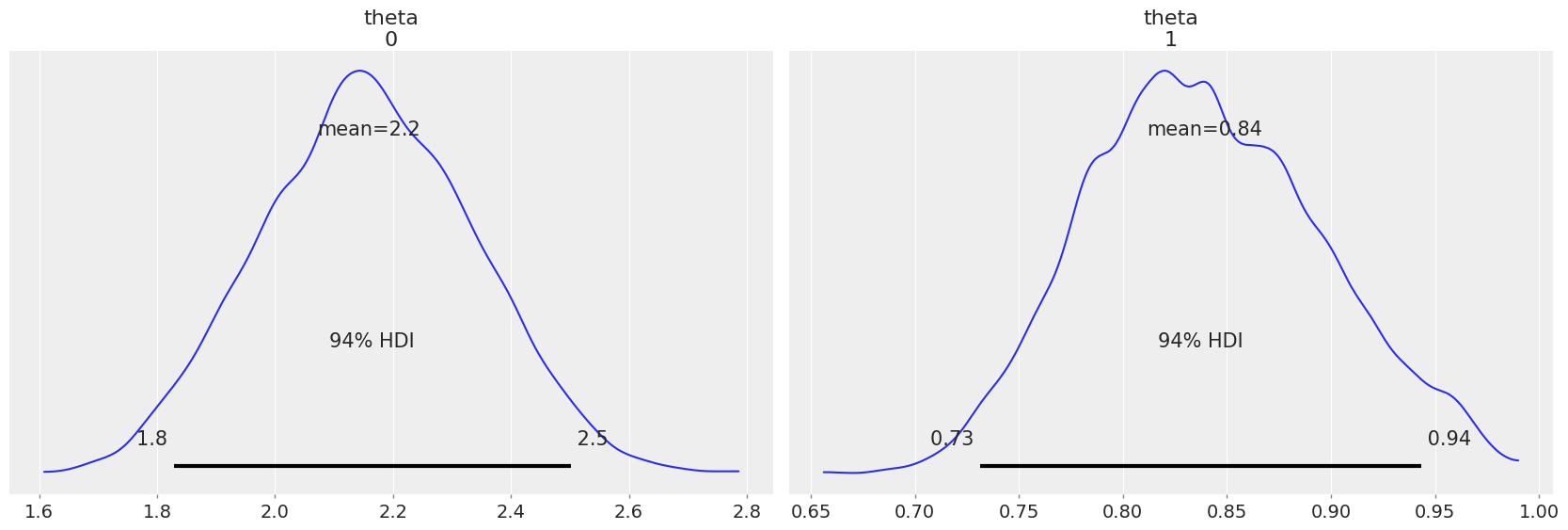
print(
f"""Given the {num_trials} we observed, the posterior is centered around
true underlying parameters theta_o: {theta_o}"""
)
Given the 100 we observed, the posterior is centered around
true underlying parameters theta_o: tensor([[1.9622, 0.7550]])
az.plot_pair(inference_data)
<Axes: xlabel='theta\n0', ylabel='theta\n1'>
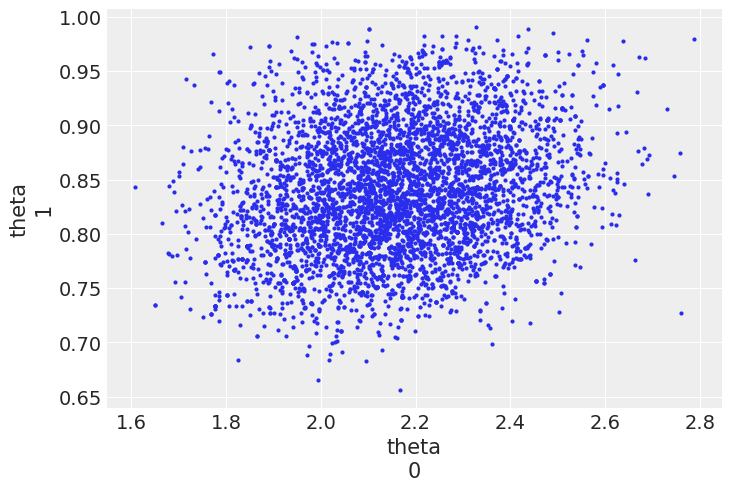
az.plot_pair(
inference_data,
var_names=["theta"],
kind="hexbin",
marginals=True,
figsize=(10, 10),
)
array([[<Axes: >, None],
[<Axes: xlabel='theta\n0', ylabel='theta\n1'>, <Axes: >]],
dtype=object)
